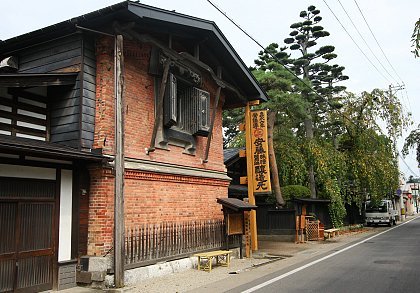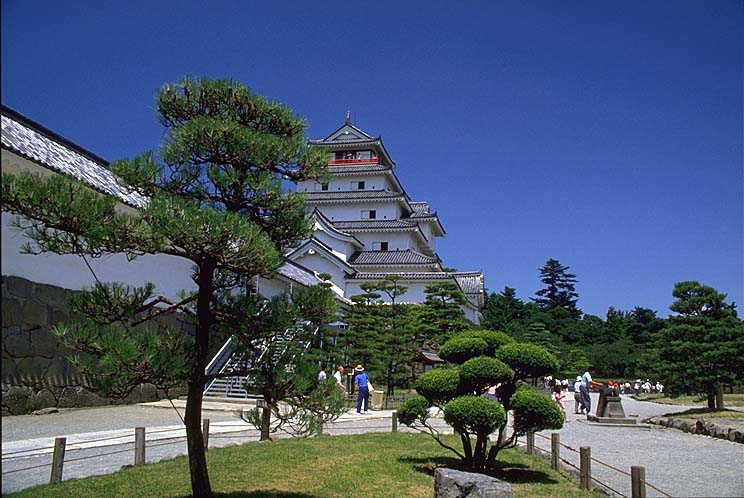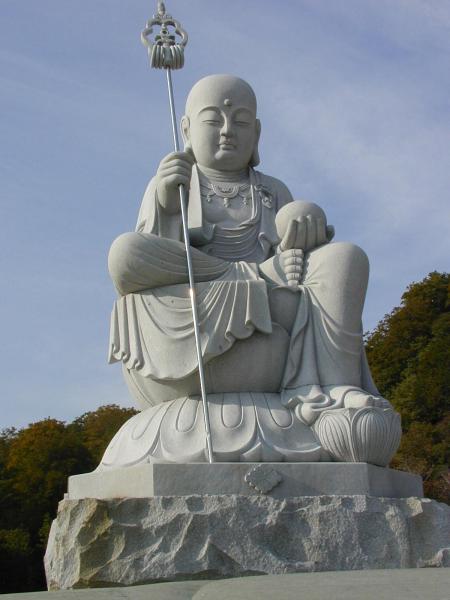![]()
Hiraizumi (平泉町, Hiraizumi-chō?) is a town located in Nishiiwai District, Iwate, Japan. It was the home of the Hiraizumi Fujiwaras for about 100 years in the late Heian era and most of the following Kamakura period. At the same time it served as the de facto capital of Oshu, an area containing nearly a third of the Japanese land area. At its height the population of Hiraizumi reached nearly a million people, rivaling Kyoto in size and splendor.[citation needed] A million people in those days would put it among the largest cities on earth.
![]()
The first structure built in Hiraizumi may have been Hakusan Shrine on top of Mount Kanzan (Barrier Mountain). A writer in 1334 recorded that the shrine was already 700 years old. Although rebuilt many times, the same shrine is still standing in the same location. In about 1100 Fujiwara no Kiyohira (藤原清衡) moved his home from Fort Toyoda in present day Esashi Ward, Oshu City to Mount Kanzan in Hiraizumi. This location was significant for several reasons. Kanzan is situated at the junction of two rivers, the Kitakami and the Koromo. Traditionally the Koromo River served as the boundary between Japan to the south and the Emishi peoples to the north. By building his home south of the Koromo Kiyohira (half Emishi himself) demonstrated his intention to rule Oshu without official sanction from the court in Kyoto. Kanzan was also directly on the Frontier Way, the main road leading from Kyoto to the northern lands as they opened up. Kanzan was also seen as the exact center of Oshu which stretched from the Shirakawa Barrier in the south to Sotogahama in present day Aomori Prefecture. Kiyohira built the large temple complex on Kanzan known as Chūson-ji. The first structure was a large pagoda at the very top of the mountain. In conjunction with this he placed small umbrella reliquaries (kasa sotoba) every hundred meters along the Frontier Way decorated with placards depicting Amida Buddha painted in gold. Other pagodas, temples and gardens followed including the Konjikido, a jewel box of a building intended to represent the Buddhist Pure Land and the final resting place of the Fujiwara lords.
Hiraizumi's golden age lasted for nearly 100 years, but after the fall of the Fujiwaras the town sank back into relative obscurity, and most of the buildings that gave the town its cultural prominence were destroyed. When the poet Matsuo Bashō saw the state of the town in 1689 he penned a famous haiku about the impermanence of human glory:
In current times Hiraizumi in one of the places that everyone visiting the Tohoku area should see. Some of the main attractions and plaves you should check out are
Motsuji Temple, Chusonji Temple, Takadachi Gikeido and the Takkoku no Iwaya.
The Motsuji Temple
![]()
For its outstanding cultural and historic value, Motsuji Temple is dually designated a Special Historic Site and a Special Place of Scenic Beauty. To the north is a hill called Mt. Doyama, before which spread out the wide open temple and garden complex. The elegance of the twelfth century garden is preserved in the mountainous formations and peninsular sea cliffs of Oizumi ga Ike Pond's rocks and the reflection of cedar and pine trees on its waters. As one of the most important sites in Japan's garden history, Motsuji's temple garden has been fully restored to its original state.
![]()
When walking around Motsuji, visitors will encounter many sign posts indicating the sites of former buildings. The foundations of these buildings have been left intact, allowing one to imagine the grandeur of Motsuji as it stood before. These same foundations inspired the celebrated haiku poet Basho to compose one of his most famous poems, in which he reflects on the impermanence of glory.
Motsuji still has a number of standing buildings that will interest visitors. Among these are the Hondo, the temple's principal hall; the Cultural Assets Repository, a treasure house displaying Motsuji's historical and cultural artifacts; and the Kaizando, a building commemorating the third head of the Tendai sect and the three Fujiwara lords who ruled over Hiraizumi.
Chusonji Temple
![]()
The Golden Hall (Kondo) of Chusonji Temple, a National Treasure, was built in 1124. The building is now sheltered by a protective concrete building, which was built in the 20th century, because the interior and exterior of the Hall is plated with glittering gold. The Hall is a reminiscence of the prosperity and culture of the region. Chusonji Temple stands in the town of Hiraizumi, Iwate Prefecture, in north-eastern Japan, now a small agricultural town with a population of less than ten thousand. However, in the 12th century, the region was a leading producer of gold and there flourished a magnificent aristocratic culture. In the late 11th century, the Fujiwara family, descendants of an offshoot of the distinguished family in Kyoto, settled in Hiraizumi and became powerful rulers of northern Japan. Since then, three generations of the family prospered here until they were overthrown in 1189. Chusonji Temple was originally founded in 850 and rebuilt by the Fujiwara family. Rebuilding started in 1105 and lasted for 21 years during which pagodas, halls, gate, bell tower, repository, and many other buildings were built in succession. In the finished complex there were over 40 temples and shrines, as well as 300 cells for priests. However, after the collapse of the Fujiwara family the prestige of the temple declined, and a fire in 1337 destroyed all the buildings except for the Golden Hall; it survived thanks to the first protective building built in 1288, and part of the sutra repository.
![]()
All other buildings remaining today except for the Golden Hall were those rebuilt in the 17th century. The Golden Hall is also a grave of the three successive heads of the Fujiwara family. On the altars under which three coffins are stored stand rows of golden Buddhist statues and accouterments, and those altars, the ceilings, and pillars are gorgeously decorated with gold, silver and jewels.
Chusonji has a number of interesting buildings apart from those dating back to the Fujiwara period. The main rituals and rites of the temple are performed at the Hondo (main hall), and there is a Treasure Hall that houses some impressive artifacts. There is also a beautiful noh theater stage. Chusonji's attractions are located along a network of paths that extend about one kilometer into the forest.
The Takadachi Gikeido
The Takadachi Gikeido is a memorial dedicated to Minamoto Yoshitsune, the younger brother of Minamoto Yoritomo. In one of Japan's most famous and tragic events, Yoshitsune was killed by the order of Yoritomo who considered his younger brother a potential rival on his way to become the absolute ruler of Japan.
Hunted by Yoritomo, Yoshitsune first found refuge in Hiraizumi, where he was finally hunted down and killed, and the city was destroyed.
Minamoto no Yoshitsune (源 義経, 1159 – June 15, 1189?) was a general of the Minamoto clan of Japan in the late Heian and early Kamakura period. Yoshitsune was the ninth son of Minamoto no Yoshitomo. Yoshitsune's older brother Minamoto no Yoritomo (the third son of Yoshitomo) founded the Kamakura shogunate. Yoshitsune's name in childhood was Ushiwakamaru (牛若丸).
![]()
Yoshitsune was born during the heiji Rebellion of 1159 in which his father and oldest two brothers were killed. His life was spared and he was put under the care of Kurama Temple 鞍馬寺, nestled in the Hiei Mountains near the capital of Kyoto, while Yoritomo was banished to Izu Province. Eventually, Yoshitsune was put under the protection of Fujiwara no Hidehira, head of the powerful regional Northern Fujiwara clan in Hiraizumi, Mutsu Province. A skillful swordsman, he defeated the legendary warrior monk Benkei in a duel. From then on, Benkei became Yoshitsune's right-hand man, eventually dying with him at the Siege of Koromogawa. In 1180, Yoshitsune heard that Yoritomo, now head of the Minamoto clan, had raised an army at the request of Prince Mochihito to fight against the Taira clan (also known as the Heike) which had usurped the power of the emperor. Yoshitsune shortly thereafter joined Yoritomo, along with Minamoto no Noriyori, all brothers who had never before met, in the last of three conflicts between the rival Minamoto and Taira samurai clans, known as the Genpei War. Yoshitsune defeated and killed his rival cousin Minamoto no Yoshinaka at the Battle of Awazu in Ōmi Province in the first month of 1184 and in the next month defeated the Taira at the Battle of Ichi-no-Tani in present day Kobe. In 1185, Yoshitsune defeated the Taira again at the Battle of Yashima in Shikoku and destroyed them at the Battle of Dan-no-ura in present day Yamaguchi Prefecture.
After the Gempei War, Yoshitsune joined the cloistered Emperor Go-Shirakawa against his brother Yoritomo. Fleeing to the temporary protection of Fujiwara no Hidehira in Mutsu again, Yoshitsune was betrayed, defeated at the Battle of Koromo River, and forced to commit seppuku along with his wife and daughter, by Hidehira's son Fujiwara no Yasuhira. Yoshitsune is enshrined in the Shinto shrine Shirahata Jinja in Fujisawa. Yoshitsune has long been a popular figure in Japanese literature and culture due to his appearance as the main character in the third section of the Japanese literary classic Heike Monogatari (Tale of the Heike). The Japanese term for "sympathy for a tragic hero", Hougan-biiki, comes from Yoshitsune's title Hougan, which he received from the Imperial Court.
The Takadachi Gikeido is one of the greatest historical locations in the Tohoku region of Japan and simply a must see.
Takkoku no Iwaya
Takkoku no Iwaya Bishamon Hall was constructed in the beginning of the Heian era. As a temple built in a rocky cavern, it is considered as the largest one in the country. Its beginning dates back to 801 when Lord General Sakanoue no Tamuramaro built a temple with 108 Bishamonten (Buddhist deity) modeled after Kyoto's Kiyomizu Temple. He did so to show his appreciation for the protection he received when he conquered the Emishi.
The following year in 802, the Takkoku-Seiko Temple was opened as a Bettoji (attached temple).
Since then, the Takkoku no Iwaya Bishamon Hall went up in flames a number of times and its many halls and Bishamonten were completely destroyed by fire in 1946.
The current Bishamon Hall was rebuilt in 1961and 27 Bishamonten statues still remain. An image of the Amida Nyorai 16.5 meters tall is engraved on the left-hand side of the big rocky cavern's outer wall. Although only its head and shoulders are currently visible, it is still considered as a valuable Buddhist image engraved on a rocky surface.
Takkoku no Iwaya stands about six kilometers outside of central Hiraizumi. There are 4-6 buses per day from Hiraizumi Station in direction of the Genbikei Gorge, which make a 15 minute stop at Takkoku no Iwaya along the way. The one way trip from Hiraizumi Station to Takkoku no Iwaya takes about 10 minutes and costs 380 yen. There are no buses during winter (December to mid April).
Alternatively, the temple can be accessed by bicycle in about 20-40 minutes.
For anyone traveling in Iwate of the Tohoku region make sure to put Hiraizumi on your list.








